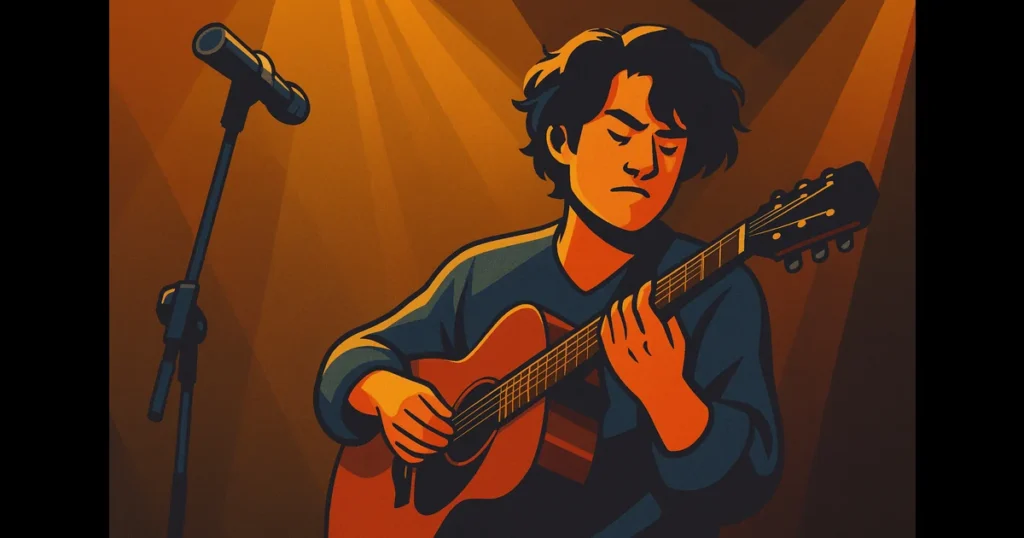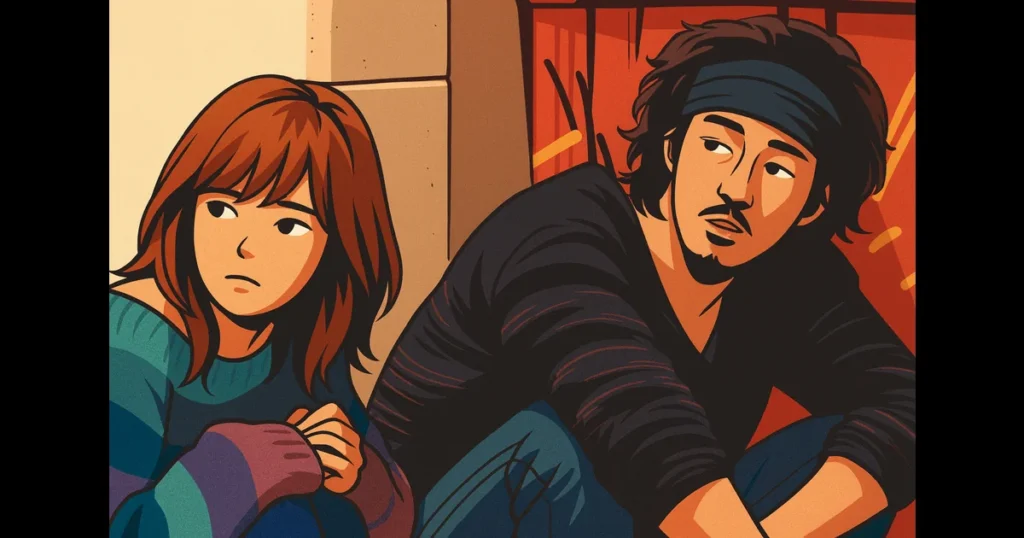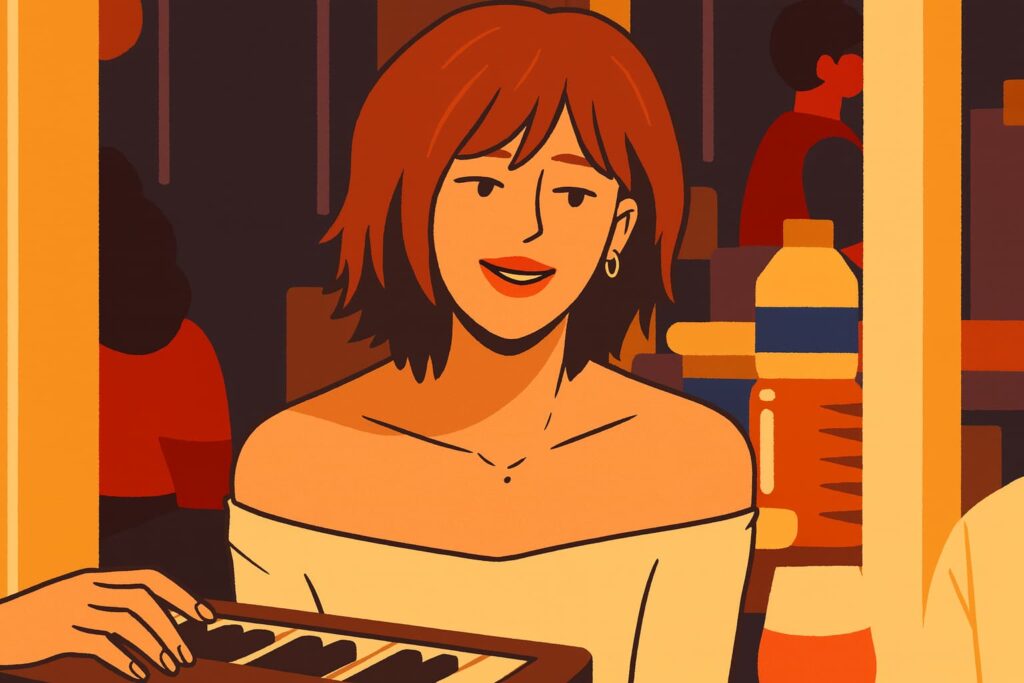[Image Source] AI illustration by DALL·E
TL;DR – “Isn’t Anyone There?” — a song of late-night loneliness and self-affirmation.
Released in 1988 by Han Young-ae, this blues/folk classic captures the Korean sentiment of han (deep unresolved sorrow) through the yearning question, “Isn’t anyone there?”The lyrics weave together calm, resignation, and faint hope in the stillness of the night, making it a timeless piece of emotional and cultural resonance.
📢 To protect copyright, all lyrics have been rephrased while preserving the original context. I appreciate your understanding.
1. Emotional Snapshot
달빛이 묵묵히 창문을 두드리는 깊은 밤, 누군가를 부르지만 대답은 돌아오지 않습니다. 그 목소리는 사실 상대를 찾기보다, 자기 존재를 확인하려는 외로운 속삭임에 가깝죠.
밤이 새고 아침이 오기 전까지, 마음속 풍경은 고요와 불안, 그리고 미묘한 기대 사이를 오갑니다.
“만약 누군가 깨어 있다면, 제발…” — 그 말 속에는 한국인의 한(恨)과 체념, 그리고 희미한 희망이 동시에 담겨 있습니다.
On a deep night where moonlight quietly knocks on the window, someone calls out—but no answer returns. This voice is less about finding another person and more like a lonely whisper confirming one’s existence.
Until morning arrives, the inner landscape shifts between calm, anxiety, and a faint sense of hope.
“If anyone’s awake… please…” — within this line lies the Korean sentiment of han (unresolved sorrow), resignation, and a flicker of hope.
🎶 Stage Performance – Lee Mu-jin
[Source] YouTube, JTBC Entertainment
🎶 Official Audio Track – Han Young-ae
[Source] YouTube, 한영애 – 주제
2. Micro-Expressions from the Lyrics
Conversational sentences inspired by the lyrics
• 여보세요? 누구 계세요? → “Hello? Is anyone there?”
– A polite greeting combined with a question.
예문: “여보세요, 혹시 이 길이 맞나요?”
Example: “Hello, is this the right road?”
• 어둠이 깔려 있어요 → “Darkness has settled.”
– Expressing a state that continues.
예문: “저녁이 되자 골목에 어둠이 깔려 있어요.”
Example: “As evening came, darkness settled over the alley.”
• 창문을 톡톡 두드리다 → “To tap lightly on the window.”
– Combining onomatopoeia with action.
예문: “비가 창문을 톡톡 두드리네요.”
Example: “The rain is lightly tapping on the window.”
• 대답하듯 미소 짓다 → “To smile as if answering.”
– Using -듯 to make a comparison.
예문: “아이의 눈빛이 고맙다고 대답하듯 반짝였어요.”
Example: “The child’s eyes sparkled as if saying thank you.”
• 밤이 긴 것 같아요 → “It feels like the night is long.”
– Expressing a feeling or assumption.
예문: “오늘은 유난히 밤이 긴 것 같아요.”
Example: “Tonight feels unusually long.”
• 아침을 보려 하다 → “Trying to see the morning.”
– Expressing intent or purpose.
예문: “커피 마시며 아침을 보려 했어요.”
Example: “I tried to stay up and see the morning while drinking coffee.”
3. Cultural Code & Subtext
– The Korean “부름(call)” sentiment: Phrases like “Isn’t anyone there?” are less literal questions and more poetic devices expressing solitude or emptiness.
– Time as emotional scenes: Night → dawn → morning symbolize emotional change.
– Tone of “-소” endings: Old-fashioned endings convey literary resonance and respectful distance.
– Metaphor of moonlight and color: Light and color often symbolize fate, longing, and loneliness.
❓FAQ – Derived from Reddit Discussions
Q1. Who performed memorable covers of “누구 없소”?
A notable modern cover comes from the indie band LUCY, which performed the song live on KBS Cool FM’s “DAY6’s Kiss the Radio” program. Fans on Reddit appreciated the rendition, noting:
“LUCY – 누구없소 (Is Anyone There) (orig. Han Young Ae) @ KBS Cool FM DAY6’s Kiss the Radio”
Q2. What interpretations or emotional tones does the song convey in covers?
While direct commentary is limited, the choice of LUCY to cover it in a radio setting—often characterized by raw, emotional performance—suggests the song continues to be valued for its deep, introspective atmosphere and poetic resonance.
Q3. Has the song sparked any scholarly or thematic comparisons in contemporary discourse?
Although not from Reddit, there’s a relevant cultural insight in a literary context: a pansori (traditional Korean musical storytelling) narration includes the phrase “거기… 거기 누구 없소?!” (“There… there, isn’t anyone there?!”), uttered by a character in peril, calling for help. This example underlines the phrase’s longstanding poetic use to evoke loneliness, plea, and existential yearning.
4. Speak Like the Song
– “혹시라도 깨어 있다면, 내 이야기를 들어줘.”
“If you’re awake, please listen to my story.”
– “어둠이 내려앉은 거리에서 너를 불러봤어.”
“I called out to you on a street where darkness had fallen.”
– “아침이 오기 전, 네가 올까 하는 마음으로 버티고 있어.”
“Before morning comes, I’m holding on, wondering if you’ll come.”
– “달빛이 대답하듯 창문에 내려앉았어.”
“Moonlight settled on the window as if answering.”
– “오늘은 그냥 조용히 자려 해.”
“Tonight, I just want to sleep quietly.”
5. Expression Drill or Quick Quiz
Q1. When do you use “-듯”?
A. To describe something that is not literal but similar in state or action.
Q2. What nuance does “없소” have in modern Korean?
A. It feels classical and literary, polite yet distant.
Q3. What is the difference between “아침을 보려 한다(trying to see the morning)” and “아침까지 버틴다(enduring until morning)”?
A. The first emphasizes purpose/hope, the second emphasizes endurance.
6. Additional Information
– Title: Isn’t Anyone There (누구 없소)
– Release: September 1, 1988
– Artist: Han Young-ae
– Genre: Blues / Folk
– Cultural Meaning: A symbolic work of Korean blues, blending solitude with social anxiety
– Notable Covers: Lee Mu-jin (2023), Jung Hong-il
📍 Want to Master Korean Mimetic Words for More Natural Speech?
Check out our Korean Sound & Descriptive Words Guide — a comprehensive resource for foreigners to understand and use over 60 vivid Korean mimetic words (의성어·의태어). Learn why they are essential for expressing emotion, adding rhythm to speech, and sounding truly fluent in everyday conversation.


